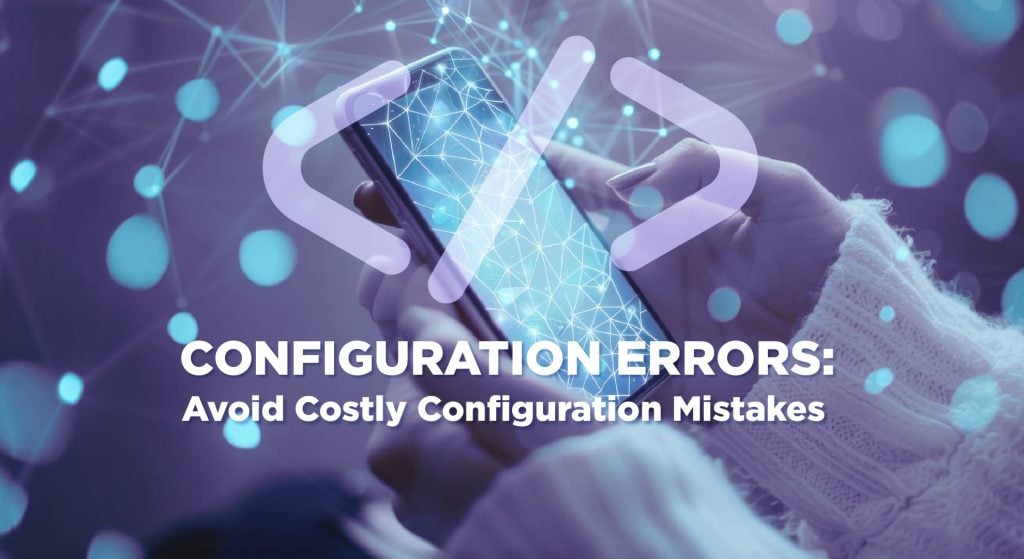Introduction
Network configuration management is a critical cornerstone in the intricate tapestry of modern telecommunications. Every network, from the smallest cellular tower to vast global infrastructures, relies on precise configurations to function optimally. However, the potential consequences of even minor errors within these configurations can be far-reaching. Service disruptions, financial losses, and eroded customer trust are some risks associated with misconfigurations.
Mobile network operations, fundamental processes for ensuring network efficiency and performance, are intrinsically linked to configuration management. When these elements are not in harmony, the entire network can suffer. Learn how to shield your network from the devastating impact of configuration errors. This post will illuminate the critical role of configuration management and offer practical guidance.
Incorrect network configurations can significantly impact performance, leading to service disruptions, increased costs, and customer dissatisfaction.
The Critical Role of Network Configuration Management System
Ensuring optimal network performance is paramount in the complex and dynamic telecommunications landscape. An effective Network Configuration Management System (NCMS) is crucial in achieving this goal. This system serves as the backbone for maintaining, monitoring, and controlling the configurations of network elements.
A robust telecom network configuration management system is essential for managing the intricate details of network components, from routers and switches to base stations. Its primary functions include:
Configuration Management Database (CMDB): Centralized storage and management of network configuration information.
Change Management: Controlling and documenting modifications to network configurations.
Configuration Audit and Compliance: Verifying configuration accuracy and adherence to standards.
Configuration Backup and Restore: Protecting network configurations from failures and enabling restoration.
Configuration Comparison and Analysis: Identifying configuration discrepancies and potential issues.
Telecom operators can simplify configuration processes, reduce errors, and enhance network efficiency using specialized Network Configuration Management Software. Mobile network configuration management software offers advanced features such as automated configuration provisioning, validation, and verification.
Integrating a Network Configuration Management Software with network planning and optimization processes is crucial for achieving optimal network performance. By aligning configuration changes with network planning objectives, operators can ensure that the network is always configured to meet evolving demands. Moreover, the software can provide valuable data for network performance analysis and optimization efforts.
In conclusion, a well-implemented Telecom Network Configuration Management System is indispensable for maintaining network stability, reliability, and performance. By understanding its functions and benefits, telecom operators can make informed decisions to optimize their networks and deliver exceptional customer service
CASE STUDY: OUTAGE CAUSED BY MISCONFIGURATION
A leading telecommunications company in the United States, provides mobile and internet services to millions of customers. However, in February 2024, they experienced a significant network outage caused by a misconfiguration error.
The Error
According to the Federal Communications Commission (FCC) investigation, a single misconfigured network element added during routine maintenance triggered the outage. CSP’s network automatically entered Protection Mode, disconnecting all wireless devices from voice services and 5G data.
Impact on Network Performance and Customer Experience
The outage was devastating. It lasted for at least 12 hours and affected millions of users nationwide. Customers could not make or receive calls, access mobile data, or utilize 5G services. This incident resulted in frustration and inconvenience and disrupted communication for businesses and individuals alike.
Financial Implications
The financial cost of the outage for MNO is difficult to quantify precisely. However, it is safe to assume significant revenue losses due to service disruptions. Additionally, the company likely faced customer churn and reputational damage.
Prevention with a Robust Network Configuration Management System(NCMS)
A robust NCMS could have prevented this outage. Here’s how:
Automated Configuration Validation: Network Configuration Management software can automatically validate configurations before deployment, identifying potential errors and preventing them from being applied.
Change Management System: Robust Network Configuration Management software integrates with a change management system, ensuring proper approval and documentation of network changes. This minimizes the risk of unauthorized or accidental misconfigurations.
Configuration Backups and Rollback: A Network Configuration Management software can maintain backups of previous configurations. In case of an error, the system can quickly restore the network to a known working state, minimizing downtime.
By implementing a comprehensive NCMS and adhering to strict change management procedures, Tier one operator could have mitigated the risk of this costly outage and ensured a more reliable network experience for its customers.
Case Study: Outage of 2020
A tier one operator in USA major force in the mobile network landscape, experienced a significant network outage in June 2020, a stark reminder of the consequences of configuration errors.
The Error
The outage stemmed from a series of missteps during a routine network upgrade. According to reports, an essential optical link went down, and the redundant link failed unexpectedly. 1 This triggered a cascading effect, resulting in an overload situation, further compounded by a routing misconfiguration introduced during the upgrade.
Impact on Network Performance and Customer Experience
A twelve-hour and thirteen-minute outage crippled Tier one operator’s 2G, 3G, and 4G networks, resulting in the catastrophic failure of over 23,000 emergency calls.
Financial Implications
The outage in June 2020 had a significant economic impact beyond lost revenue. Here’s a breakdown of the known costs:
FCC Fine: Following an investigation, the FCC levied a $19.5 million fine on MNO for failing to comply with 911 service rules during the outage. This fine underscores the potential regulatory consequences of network outages impacting emergency services.
Lost Revenue: Disruptions in voice, text, and data services undoubtedly led to lost revenue for MNO. The exact amount is not publicly available, assuming a substantial financial loss for a nationwide outage over 12 hours.
Customer Churn: Frustrated customers who experienced significant service disruptions might have switched to competing carriers. Customer churn can have a lasting impact on a company’s revenue stream.
Reputational Damage: Network outages can damage a company’s reliability and customer service reputation. The outage’s negative publicity could have impacted MNO’s brand image and future customer acquisition efforts.
Internal Costs: The investigation and restoration efforts associated with the outage likely incurred internal costs for MNO, further impacting their bottom line.
Prevention with a Robust NCMS
A robust Network Configuration Management System (NCMS) could have played a critical role in preventing this outage:
Automated Redundancy Checks: Network Configuration Management Software can be programmed to automatically verify the functionality of redundant systems, such as backup links, ensuring they operate correctly.
Configuration Change Control: A robust Network Configuration Management Software integrates with change management processes, ensuring proper review and approval for network modifications. This minimizes the risk of introducing configuration errors during upgrades.
Real-time Monitoring and Alerts: Advanced NCMS offers real-time network performance monitoring and can trigger alerts for potential issues. This allows for early detection and intervention before problems escalate into outages.
By implementing a comprehensive Network Configuration Management Software and adhering to rigorous change management procedures, MNO could have significantly reduced the risk of this outage and ensured a smoother network upgrade process
Typical Configuration Mistakes and Their Consequences
Configuration errors in telecom networks can have far-reaching implications, impacting everything from network performance to customer experience. Let’s explore some common mistakes and their potential consequences.Common Configuration Errors in Telecom Networks
As we’ve discussed, configuration errors can occur at various levels of the network. Some of the most common mistakes include:
Incorrect IP addressing: Misconfigured IP addresses can lead to routing issues, network inaccessibility, and communication failures.

Firewall misconfigurations: Overly restrictive or permissive firewall rules can disrupt network traffic, impact application performance, and create security vulnerabilities.
Routing protocol errors: Incorrectly configured routing protocols can cause routing loops, black holes, and network instability.
DNS misconfigurations: Errors in DNS settings can prevent devices from resolving domain names, hindering internet access.
VLAN configuration mistakes: Incorrect VLAN configurations can lead to network segmentation issues, communication problems, and security risks.
QoS misconfigurations: Improper QoS settings can result in poor application performance, network congestion, and degraded user experience.
Typical Configuration Mistakes and Their Consequences
Configuration errors in telecom networks can have far-reaching implications, impacting everything from network performance to customer experience. Let’s explore some common mistakes and their potential consequences.

Common Configuration Errors in Telecom Networks
As we’ve discussed, configuration errors can occur at various levels of the network. Some of the most common mistakes include:
Incorrect IP addressing: Misconfigured IP addresses can lead to routing issues, network inaccessibility, and communication failures.
Firewall misconfigurations: Overly restrictive or permissive firewall rules can disrupt network traffic, impact application performance, and create security vulnerabilities.
Routing protocol errors: Incorrectly configured routing protocols can cause routing loops, black holes, and network instability.
DNS misconfigurations: Errors in DNS settings can prevent devices from resolving domain names, hindering internet access.
VLAN configuration mistakes: Incorrect VLAN configurations can lead to network segmentation issues, communication problems, and security risks.
QoS misconfigurations: Improper QoS settings can result in poor application performance, network congestion, and degraded user experience.
The Domino Effect of Configuration Errors
Configuration errors often have a cascading effect, impacting multiple network components and services. For example, a misconfigured router can disrupt traffic flow, leading to congestion and increased latency. It, in turn, can affect other network devices and services, ultimately impacting end-users.
Impact of Configuration Errors on Network KPIs
Configuration errors directly impact key performance indicators (KPIs) that measure network health and performance. Some of the affected KPIs include:
Mean Time Between Failures (MTBF): Configuration errors can increase the frequency of network failures, reducing MTBF.
Mean Time To Repair (MTTR): Identifying and resolving configuration issues can be time-consuming, increasing MTTR.
Service Level Agreements (SLAs): Configuration errors can lead to service disruptions, impact SLAs, and potentially result in financial penalties.
Customer Satisfaction: Network outages and performance issues caused by configuration errors can erode customer satisfaction and loyalty.
Network Utilization: Incorrect configurations can lead to inefficient resource utilization, impacting network capacity and performance.
Best Practices for Network Configuration Management
Effective network configuration management ensures optimal performance, reliability, and security in today’s complex telecom environments. By adhering to best practices, telecom operators can significantly reduce the risk of configuration errors, optimize network operations, and improve overall service quality.
The Importance of Accurate Documentation
Comprehensive and up-to-date documentation is the cornerstone of effective network configuration management. Detailed records of network configurations, changes, and troubleshooting steps are essential for:
Understanding network topology: Visualizing the network infrastructure and identifying dependencies.
Facilitating troubleshooting: Quickly isolating and resolving issues.
Supporting audits and compliance: Demonstrating adherence to regulatory requirements.
Enabling effective handover: Ensuring smooth knowledge transfer between team members.
By maintaining accurate and accessible documentation, telecom operators can streamline network management processes and reduce the time spent troubleshooting.
The Role of Change Management in Preventing Errors
A robust change management process is crucial for preventing configuration errors and minimizing their impact. By following a structured approach to network modifications, organizations can:
Reduce human error risk: Implement thorough change approval processes and checklists.
Ensure impact assessment: Evaluating the potential consequences of changes before implementation.
Maintain configuration consistency: Tracking and documenting all changes to the network.
Enable rollback: Creating backups and version control for configurations.
Telecom operators can enhance network stability and reliability by integrating change management into mobile network operations and configuration management processes.
Regular Audits and Testing
Regular audits and testing are essential for identifying and rectifying configuration errors before they cause significant issues. It involves:
Configuration compliance checks: Verifying network configurations adhere to established standards and policies.
Performance testing: Assessing network performance under various conditions to identify bottlenecks and configuration-related issues.

Security audits: Identifying vulnerabilities and weaknesses in network configurations.
By incorporating regular audits and testing into network planning and optimization strategies, telecom operators can proactively address configuration issues and improve overall network resilience.
The Benefits of Automation in Configuration Management
Leveraging automation in network configuration management can significantly enhance efficiency, accuracy, and speed. By automating routine tasks such as configuration provisioning, validation, and deployment, telecom operators can:
Reduce human error: Minimizing the risk of manual configuration mistakes.
Improve efficiency: Accelerating configuration processes and reducing time-to-market for new services.
Enhance scalability: Supporting network growth and expansion.
Improve consistency: Ensuring standardized configurations across the network.
Automation is a crucial component of modern Telecom network configuration management systems and can contribute to significant cost savings and improved network performance.
Continuous Training for Network Engineers
Investing in the training and development of network engineers is essential for maintaining a skilled workforce. Continuous training programs should cover:
Latest technologies and trends: Keeping engineers up-to-date with industry advancements.
Configuration management best practices: Enhancing knowledge of effective configuration management techniques.
Problem-solving and troubleshooting skills: Improving engineers’ ability to diagnose and resolve issues.
Security awareness: Educating engineers about the importance of secure network configurations.
By fostering a culture of continuous learning, telecom operators can build a highly competent team capable of effectively managing complex network environments
The Role of Change Management in Preventing Errors
A robust change management process is crucial for preventing configuration errors and minimizing their impact. By following a structured approach to network modifications, organizations can:
Reduce human error risk: Implement thorough change approval processes and checklists.
Ensure impact assessment: Evaluating the potential consequences of changes before implementation.
Maintain configuration consistency: Tracking and documenting all changes to the network.


The Role of Change Management in Preventing Errors
A robust change management process is crucial for preventing configuration errors and minimizing their impact. By following a structured approach to network modifications, organizations can:
Reduce human error risk: Implement thorough change approval processes and checklists.
Ensure impact assessment: Evaluating the potential consequences of changes before implementation.
Maintain configuration consistency: Tracking and documenting all changes to the network.
Enable rollback: Creating backups and version control for configurations.
Telecom operators can enhance network stability and reliability by integrating change management into mobile network operations and configuration management processes.
Regular Audits and Testing
Regular audits and testing are essential for identifying and rectifying configuration errors before they cause significant issues. It involves:
Configuration compliance checks: Verifying network configurations adhere to established standards and policies.
Performance testing: Assessing network performance under various conditions to identify bottlenecks and configuration-related issues.
Security audits: Identifying vulnerabilities and weaknesses in network configurations.
By incorporating regular audits and testing into network planning and optimization strategies, telecom operators can proactively address configuration issues and improve overall network resilience.
The Benefits of Automation in Configuration Management
Leveraging automation in network configuration management can significantly enhance efficiency, accuracy, and speed. By automating routine tasks such as configuration provisioning, validation, and deployment, telecom operators can:
Reduce human error: Minimizing the risk of manual configuration mistakes.
Improve efficiency: Accelerating configuration processes and reducing time-to-market for new services.
Enhance scalability: Supporting network growth and expansion.
Improve consistency: Ensuring standardized configurations across the network.
Automation is a crucial component of modern Telecom network configuration management systems and can contribute to significant cost savings and improved network performance.
Continuous Training for Network Engineers
Investing in the training and development of network engineers is essential for maintaining a skilled workforce. Continuous training programs should cover:
Latest technologies and trends: Keeping engineers up-to-date with industry advancements.
Configuration management best practices: Enhancing knowledge of effective configuration management techniques.
Problem-solving and troubleshooting skills: Improving engineers’ ability to diagnose and resolve issues.
Security awareness: Educating engineers about the importance of secure network configurations.
By fostering a culture of continuous learning, telecom operators can build a highly competent team capable of effectively managing complex network environments
Conclusion
Network configuration management is a critical function that underpins modern telecommunications networks’ performance, reliability, and security. As demonstrated, even minor configuration errors can have far-reaching consequences, leading to service disruptions, financial losses, and reputational damage.
To mitigate these risks, telecom operators must invest in robust Network Configuration Management Systems (NCMS) that incorporate best practices such as accurate documentation, change management, regular audits, and automation. Operators can significantly improve network efficiency, reduce operational costs, and enhance customer satisfaction by prioritizing configuration management.
Contact Innovile today to learn more about optimizing your network configuration management practices and unlocking your network’s full potential. Our experts can offer customized solutions to satisfy your specific network configuration requirements.
Contact Innovile for expert knowledge on network configuration management solutions.


